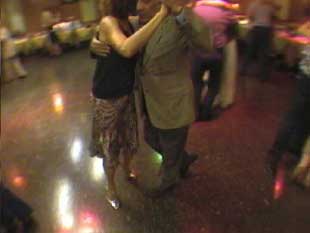Training the Eye
I suppose there are two basic ways to study tango. One is to drill down close—to focus in on the best dancers, and attempt to analyze each move. The other way is to step back and take a longer view—to watch how the good dancers embrace and move, and try to absorb the whole package.
I realize that most beginners tend to use the first approach. They want to take things apart and see what makes them tick—and it's a very effective way to learn. But in tango the key is to know which things are worth such close scrutiny. Dancers who spend too much time analyzing patterns and “moves” tend to develop a mechanical style that’s easy to spot. And if you dance that way in the clubs, you’ll quickly join the ranks of the invisible people. For me, there are only three things in tango that are worth putting under a microscope: Cadence, Posture, and Step. You can’t examine them too closely, and you can’t practice them too much. And in the next chapter, we’ll try to help you do that—but as we present the videos in this chapter, our emphasis will be on taking the longer view.
It was only after spending several years dancing close to the milongueros and absorbing the look and feel of their dancing that I began to understand tango. I didn't necessarily study the best dancers directly, but they were always nearby. Always in my peripheral vision. So I would suggest using these videos in a similar way. Instead of approaching them head on, use them as an opportunity to soak up the postures and rhythms of these great dancers. Analyze them if you want, but then return to them from time to time without any particular plan. Don't watch them in any particular order. Simply enjoy them whenever you feel like it, and over time, you'll begin to know what good tango looks like. Use your peripheral vision, and eventually, you'll develop an eye for tango. If you can’t see it you can’t dance it.
